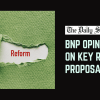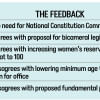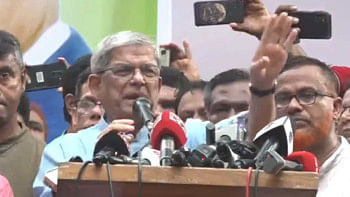How creative stagnation triggers political resurrection

In the grand theatre of democratic politics, few phenomena are as startling as the resurrection of discredited political dynasties. Defying conventional wisdom about political accountability, we see this recurring pattern across South and Southeast Asia. Families and parties, once thought politically extinct, often return to power not through reform but through a persistent absence of viable alternatives. This is the "vacuum cycle," a phenomenon born from weak creative economies that produce risk-averse societies incapable of imagining new political narratives.
The impossible resurrections
Consider Pakistan, where the Sharif family's ignoble exit seemed permanent. Corruption scandals, Panama Papers revelations, and public disgrace appeared to seal their fate. Yet, Shahbaz Sharif leads the country again, proving that in the vacuum cycle, no political death is permanent. Even Pakistan Tehreek-e-Insaf's (PTI) rise offered hope before being crushed, creating another vacuum. Today, PTI faces fierce slander while its leader sits imprisoned, only to inevitably rise again when the cycle demands it. The see-saw between Pakistan People's Party (PPP) and the Muslim League has become a full-scale wheel of fortune, with three options whose punishment and reward cycles seem fatalistically predetermined.
In India, the Congress Party's decimating defeat seemed to herald a new era. The Gandhi family appeared finished, their dynastic politics thoroughly rejected. Yet, as Modi's tenure reaches its critical juncture, the vacuum cycle positions a once-irrelevant party as kingmaker—not through reform, but because voids demand familiar shapes.
Bangladesh offers the most striking example. The Awami League's return in the late 1990s, after being branded a "traitor party," marked the first revolution of the wheel. Now in 2025, the much-maligned Bangladesh Nationalist Party (BNP) positions itself to inherit power from Dr Muhammad Yunus's transitional government. The machinery of return is already in motion, driven by exhausted alternatives and a wizened party with no major reforms visible.
Thailand tells an astounding story of family political resurrection. The Pheu Thai Party has seen three prime ministers from the same family: Thaksin Shinawatra, his sister Yingluck, and now his daughter Paetongtarn, the current prime minister. Despite Thaksin's 2006 ouster, self-exile, and his party being outlawed, the family keeps returning through events bordering on magical realism. The vacuum cycle plays out blatantly as the punished party completes its return to glory.
Perhaps nowhere is this more acute than the Philippines, where Ferdinand Marcos's 1986 ouster seemed to deliver irreversible historical judgement. His wife Imelda became an icon of plunder with her infamous collection of shoes, coats, and handbags discovered during their flight. Yet, 36 years later, their son Bongbong won the 2022 election by a landslide, securing almost 50 percent of the votes. Today, he is president, his family's reputation restored while his opponent Rodrigo Duterte faces International Criminal Court charges.
The mechanics of the vacuum
The vacuum cycle rewards the worst punishment with the best outcomes. But what drives this relentless pattern? The answer lies not in discredited politicians' resilience, but in the structural weakness of societies that repeatedly embrace them. At the heart lies a critical absence: the lack of new political parties capable of gaining traction, and more fundamentally, the absence of self-reliant creative economies that could foster the intellectual confidence necessary for political experimentation.
When voters face impoverished choices, they engage in political nostalgia, reminiscing about earlier periods when life seemed less complicated. This reflects a deeper psychological truth: people's core desire to return to regular lives after driving revolutionary changes. The initial energy that topples corrupt dynasties is extraordinary but unsustainable. Revolutionary moments demand tremendous civic engagement and psychological strain. Once immediate crises pass, societies naturally seek normality. But without compelling alternatives, normality becomes synonymous with the familiar, even if previously rejected.
The creative economy connection
Here lies the crucial insight: except for India and Thailand, the above-mentioned countries lag significantly in developing robust creative economies. This deficit is not merely economic but fundamentally political. The connection between creative industries and political innovation operates through three interconnected mechanisms.
The cognitive mechanism: Creative industries train people in divergent thinking—the ability to generate multiple solutions to single problems. When societies regularly engage diverse narratives through film, literature, music, and digital media, they develop cognitive flexibility. This creates comfort with political experimentation and "narrative courage"—the intellectual confidence to try new stories about governance and leadership.
The economic mechanism: Creative economies generate human capital spillovers. Skills developed in creative industries—critical thinking, collaborative problem-solving, comfort with ambiguity—create workforces naturally suited for political innovation. More importantly, creative industries provide economic alternatives to traditional patronage systems, reducing dependence on political parties for employment and social mobility.
The social mechanism: Creative industries function as "weak-tie networks"—social connections bridging different communities, classes, and ideologies. Unlike traditional political networks that reinforce divisions, creative collaborations bring together diverse groups around shared projects. Film productions, art exhibitions, or digital creative work create temporary but meaningful alliances across social boundaries. These cross-cutting networks become foundations for new political coalitions transcending dynastic loyalties.
Consider South Korea's transformation. K-Pop's global success didn't just boost exports. It rewired Korean society's relationship with innovation and risk-taking. Young Koreans who consumed and created boundary-pushing cultural content became comfortable challenging political norms. The cognitive flexibility that produced genre-bending music also produced sustained civic movements that impeached Park Geun-hye. The candlelight vigils that brought down a president used similar collaborative networks as Korea's cultural exports.
Taiwan validates this pattern. The island's creative renaissance, from internationally acclaimed cinema to innovative digital democracy experiments, reflects a society valuing originality over imitation. Taiwanese film-makers competing globally with Hollywood developed the confidence to create political institutions competing with Washington and Beijing models. Creative confidence that produced unique cultural products also produced unique democratic innovations.
However, the reverse is equally true. When creative industries face erosion through imposed ideology, political outlook suffers. India's creative industries have recently declined through communal polarisation and political cronyism, increasingly reflected in its political discourse and democratic institutions—the exact opposite of what should happen.
The self-reliance imperative
The emphasis on "self-reliant" creative economies reveals why imported cultural content cannot substitute for indigenous creative capacity. Countries dependent on foreign cultural content—consuming Hollywood, Bollywood, or K-dramas without producing competitive alternatives—remain trapped in "narrative colonialism," becoming consumers rather than creators of stories about human possibility.
Breaking the cycle
The vacuum cycle represents more than a political phenomenon, it reveals a broader failure of imagination. Societies trapped in this cycle can destroy what they dislike but cannot create what they need. Only when societies develop the capacity to tell new stories about themselves can they escape the gravitational pull of old political narratives.
Until then, the wheel will continue turning, bringing back dynasties we thought buried—not because they deserve power, but because we failed to imagine alternatives. The health of democracy may depend less on electoral institutions than on creative industries, for it is in the realm of imagination where political possibilities are born. Without it, even the most dramatic revolutionary moments become mere preludes to resurrection.
Amber M Islam is executive creative director at Grey Group.
Views expressed in this article are the author's own.
Follow The Daily Star Opinion on Facebook for the latest opinions, commentaries and analyses by experts and professionals. To contribute your article or letter to The Daily Star Opinion, see our guidelines for submission.

 For all latest news, follow The Daily Star's Google News channel.
For all latest news, follow The Daily Star's Google News channel. 











Comments